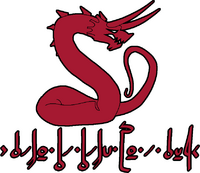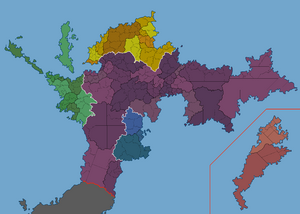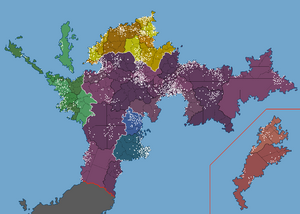Umetuč: Difference between revisions
No edit summary |
No edit summary |
||
| Line 59: | Line 59: | ||
===Industry=== | ===Industry=== | ||
North Umetuč is a fairly industrialized nation. It's most developed sectors are: common metals extraction and refinery, artillery and weapon production, asphalt and concrete production, chemical manufacturing, glass manufacturing. These sectors are more developed than others thanks to the specific resources and minerals available inside Nort Umetuč's borders. Along these industries, North Umetuč has a fairly developed timber and fishing industry. Due to the dense raiforests and, overall inhospitable terrain and poor soil, intensive agriculture is not a very remunerating area. | North Umetuč is a fairly industrialized nation. It's most developed sectors are: common metals extraction and refinery, artillery and weapon production, asphalt and concrete production, chemical manufacturing, glass manufacturing. These sectors are more developed than others thanks to the specific resources and minerals available inside Nort Umetuč's borders. Along these industries, North Umetuč has a fairly developed timber and fishing industry. Due to the dense raiforests and, overall inhospitable terrain and poor soil, intensive agriculture is not a very remunerating area. | ||
==Demographics== | ==Demographics== | ||
North Umetuč is home to several ethnic groups and communities. The most prominent and numerous of these are the Tokagebač and the Mtàd Tokagebač, native to the northern areas of the island. The two Tokagebač groups have always been collaborating since the recent (late 23th century) split from which the Mtàd split from their western cousins. Some scholars argue that the linguistic differences between these communities are irrelevant and that the Tokagebač and the Mtàd are actually still part of the same ethnic cathegory. Another Indigenous group is the Cruiniiral, | |||
===Education=== | ===Education=== | ||
Revision as of 16:54, 12 May 2023
The United Republics of North Umetuč ([u.ˈmɛ.tʼut͡ʃ] in Tokagebač) is a federal autoritarian parliamentary republic on the northern edges of the South Sea, in the continent of Syrovoho in Sonhel. It takes its name from the island of Umetuč, of which it occupies the northern part. The current territories occupied by the United Republics of North Umetuč were firstly settled in the 10th century by the nomadic tribes who will later adopt the names of Tokagebac, Cruiniiral, Valtarans and Albionians. Umetuč shares the island with the Kingdom of Nova Albion to the south, which controls the remaining half of the island.
The United Republics of North Umetuč Mesa Umetučobe Nekjagoxo tonekekra | |
|---|---|
| Motto: | |
| Anthem: | |
 Map of North Umetuč in 2408 | |
| Capital and largest city | Tålakjemeqa |
| Official languages | Tokagebac |
| Recognised national languages | Tokagebac, Xopukuli, Mtàd Tokagebac |
| Recognised regional languages | Tokagebac, Cruiniiral, Ax tot Yonn, Dj̆ty, Xopukuli, Muippelore, Mtàd Tokagebac |
| Ethnic groups | Tokagebac, Xopukuli, Mtàd Tokagebac, Cruiniiral, Ax tot Yonn, Dj̆ty, Muippelore |
| Demonym(s) | Umetučite, Tokagebac |
| Government | Autoritarian parlamentary federal republic |
• President | Slabjo Čiček |
| Legislature | North Umetǔcite Parliament |
| Establishment | |
• Intervention in the Valtaran Civil War and establishment of the United Republics of North Umetuč | 2403 |
| Population | |
• Estimate | 28,915,215 |
• Density | 34/km2 (88.1/sq mi) |
| Currency | Nekjagod (₦) |
| Date format | DD/MM/YYYY |
| Driving side | right |
History
Geography
Umetuč is located on the northern half of the main island of the Tumetuč Archipelago, called Umetuč. The country is split in two sides by the Čytmekjem mountan range, which than is interrupted by the Čid̨ud̨ig valley. In the eastern peninsula there is also another mountain, detached from the Čytmekjem, called B̨ob̨ekokib. The highest peak inside Umetučite border is the Ubebro mountain which stands at around 2800 meters in the western regions of the country. The Ubebro is also the source of the only river in the Umetuč island: the B̨obočim, which untimately flows in the Blood Sea (the area of the ocean between the minor Western Umetuč Islands and the Gnawing Gulf) splitting the capital Tålakjemeqa in half. North Umetuč is located in the equatorial belt and is therefore mostly covered in a thick rainforest from the Gnawing Guld to the eastern tip of the island. It also includes, in its south-western regions, a chunk of sandy desert that covers the western coasts of the island. Normally North Umetuč experiences a wet and hot season, which lasts between three and four months, along a colder season, in which precipitaion are slightly less abundant and average temperatures decrease by a few degrees.
Politics and government
North Umetuč is a federal parlamentary republic founded in 2402 after the collapse of the Valtaran States in the Valtaran Civil War. It includes the Republic of Greater G̨enseba, the Republic of Xirakekunnae, the Republic of C'aarllaac and the New Republic of Miše. Each of the republics have their own local bicameral parliament which has to enforce federally appproved laws and directives or has the possibility to contest them and have them adapted to their territory. The republics can also enforce exclusive laws that do not conflict with already approved federal laws and that do not regard economic policies, law and order, foreign politics, production and industrial projects and national defense. The federal government, composed of the president (which since 2405 also holds executive power) and of the bicameral parliament formed by elected representatives from the republics, is a supernational entity and has the power to impose laws and rules on the republics. The parliament is elected every four years with a proportional popular vote. The president is later elected by the two chambers of parliament every five years. The parliament can depose the current president and replace them thanks to a vote of no confidence that requires two thirds of both chambsers to pass. The president can disbandle one of the two chambers of parliament with a vote that needs 80% of the votes from the other parliament chamber.
Military
The Umetuč Armed Forces are split between Field Army and Navy. Both these entities are controlled by the federal government but are internally administrated by generals and admirals elected by parliament every six years.
Foreign relations
North Umetuč is a founding member of the Amarian Combine and is currently its leader. It also is a founding member of the Transnational Assembly, association from which Umetuč has been pregressively less prominent and enthusiastically participant in. North Umetuč is a member of the International Fueling Treaty since 2407 and has created tight economic, political and cultural relations with tits members.
Economy
Umetuč is an industrialized nation with a triving mining industry and weapon production sector. As of 2408, Umetuč has an employement rate of around 80% thanks to its interventionist policies and its ban on private enterprises. The government has virtually full control over the primary and secondary secotrs of th ecountry and has liberalized mostly the retail, communication and turism sectors. Freelance work is also accepted in Umetuč as long as its declared to and approved by the government and is taxed appropriately.
Energy
Most of the Energy production in Umetuč comes from its rich coal mines scattered all over the country. Each republic has access to several mines and refinery stations capable of producing several thousands tons of coal yearly, which are than shipped to the rest of the country to power most of its industrial apparatus. Some of the largest cities are almost entirely powered by coal implants that produce a moderate amount of electricity.
Industry
North Umetuč is a fairly industrialized nation. It's most developed sectors are: common metals extraction and refinery, artillery and weapon production, asphalt and concrete production, chemical manufacturing, glass manufacturing. These sectors are more developed than others thanks to the specific resources and minerals available inside Nort Umetuč's borders. Along these industries, North Umetuč has a fairly developed timber and fishing industry. Due to the dense raiforests and, overall inhospitable terrain and poor soil, intensive agriculture is not a very remunerating area.
Demographics
North Umetuč is home to several ethnic groups and communities. The most prominent and numerous of these are the Tokagebač and the Mtàd Tokagebač, native to the northern areas of the island. The two Tokagebač groups have always been collaborating since the recent (late 23th century) split from which the Mtàd split from their western cousins. Some scholars argue that the linguistic differences between these communities are irrelevant and that the Tokagebač and the Mtàd are actually still part of the same ethnic cathegory. Another Indigenous group is the Cruiniiral,



